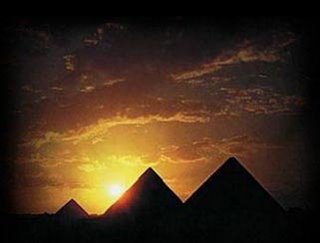
The pyramids of Egypt, among the largest constructions ever built by man, constitute one of the most potent and enduring symbols of Ancient Egyptian civilization. It is generally accepted by most archaeologists that they were constructed as burial monuments associated with royal solar and stellar cults, and most were built during the Old and Middle Kingdom periods from 2575 B.C. to 1648 B.C.
The Great Pyramid of Cholula, the world's largest monument and largest Pre-Columbian pyramid by volume, is a huge complex located in Cholula,  Puebla, Mexico.
Puebla, Mexico.
Only a fraction of a staircase on one side of the Great Pyramid of Cholula has been restored to its former glory.
The temple-pyramid complex was built over many generations, from the 2nd century BC to the early 16th century, and was dedicated to the deity Quetzalcoatl. It has a base of 450 by 450 m (1476x1476 ft) and a height of 66 m (217 ft). According to the Guinness Book of Records, it is in fact the largest pyramid as well as the largest monument ever constructed anywhere in the world, with a total volume estimated at 4.45 million m³, almost one third larger than that of the Great Pyramid of Giza in Egypt. (The Giza pyramid is higher, however.) The Aztecs believed that Xelhua built the Great Pyramid of Cholula.
A ziggurat (Babylonian ziqqurrat, D-Stem of zaqāru "to build on a raised area") is a temple tower of the ancient Mesopotamian valley and Iran, having the form of a terraced pyramid of successively receding stories. Ziggurats were a form of temple tower common to the Sumerians, Babylonians and Assyrians of ancient Mesopotamia. The earliest examples of the ziggurat were simple raised platforms that date from the Ubaid period during the fourth millennium BCE and the latest date from the 6th century BCE. The step pyramid style began near the end of the Early Dynastic Period. Built in receding tiers upon a rectangular, oval, or square platform, the ziggurat was a pyramidal structure. Sun-baked bricks made up the core of the ziggurat with facings of fired bricks on the outside. The facings were often glazed in different colors and may have had astrological significance. The number of tiers ranged from two to seven, with a shrine or temple at the summit. Access to the shrine was provided by a series of ramps on one side of the ziggurat or by a spiral ramp from base to summit. Notable examples of this structure include the Great Ziggurat of Ur and Khorsabad in Mesopotamia.
The earliest examples of the ziggurat were simple raised platforms that date from the Ubaid period during the fourth millennium BCE and the latest date from the 6th century BCE. The step pyramid style began near the end of the Early Dynastic Period. Built in receding tiers upon a rectangular, oval, or square platform, the ziggurat was a pyramidal structure. Sun-baked bricks made up the core of the ziggurat with facings of fired bricks on the outside. The facings were often glazed in different colors and may have had astrological significance. The number of tiers ranged from two to seven, with a shrine or temple at the summit. Access to the shrine was provided by a series of ramps on one side of the ziggurat or by a spiral ramp from base to summit. Notable examples of this structure include the Great Ziggurat of Ur and Khorsabad in Mesopotamia.
The Mesopotamian ziggurats were not places for public worship or ceremonies. They were believed to be dwelling places for the gods. Through the ziggurat the gods could be close to mankind and each city had its own patron god. Only priests were permitted on the ziggurat or in the rooms at its base and it was their responsibility to care for the gods and attend to their needs. As a result the priests were very powerful members of Sumerian society.
Saturday, September 16, 2006
Pyramids
at
6:06 PM
![]()
Subscribe to:
Post Comments (Atom)
No comments:
Post a Comment